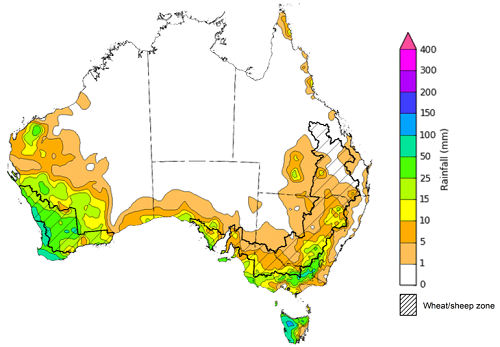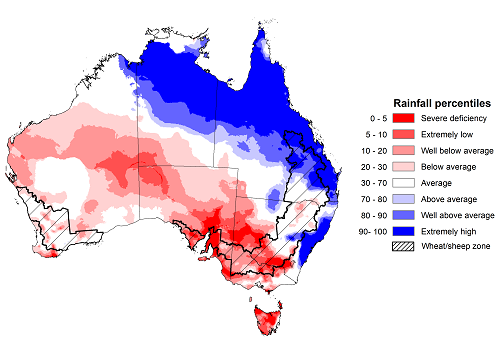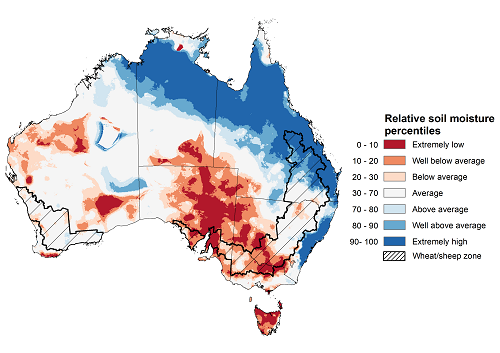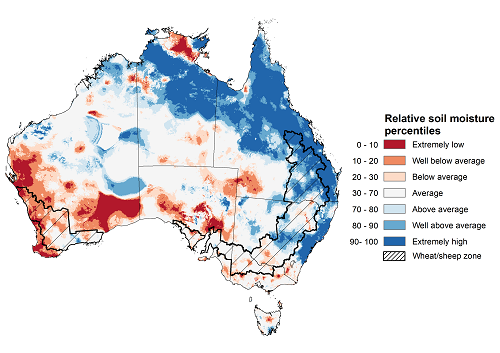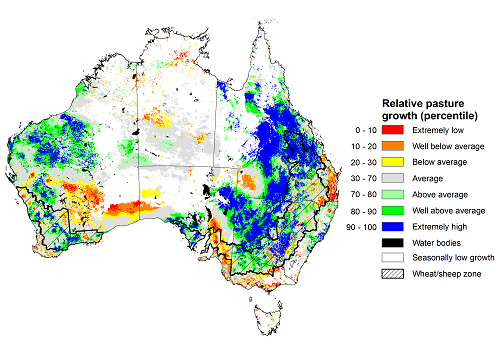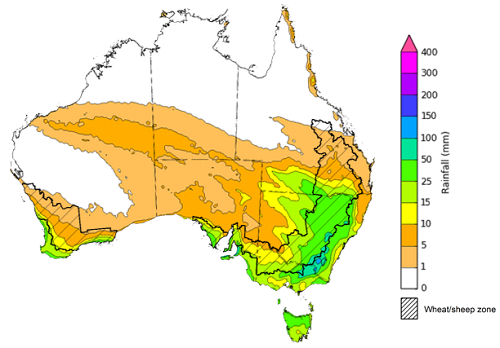Key issues
- For the week ending 3 August 2022, low-pressure troughs and cold fronts swept across southern Australia, resulting in rainfall and strong winds. Over remaining parts of the country, high-pressure systems brought clear, dry conditions.
- Continued rainfall across Western Australian cropping regions over the past week has boosted soil upper layer soil moisture levels to average to well above average. Despite another week of relatively dry conditions across Queensland cropping regions, soil moisture levels remain above average. Conditions across cropping regions of south-eastern Australia remain mixed, with further rainfall over the coming weeks needed to maintain winter crop yield potentials.
- Rainfall during July 2022 was 2% above average for Australia as a whole. Rainfall was above average to extremely high for parts of eastern and northern New South Wales, northern and eastern Queensland and the north of the Northern Territory. However, rainfall was extremely low to below average for most of western and southern New South Wales, Victoria, South Australia, Tasmania and scattered areas of southern Western Australia.
- Modelled pasture growth was extremely low to below average across parts of south-western and south-eastern Queensland, southern Victoria, south-eastern South Australia, south-eastern Western Australia, and parts of central Northern Territory. In contrast, modelled pasture growth was above average to extremely high across much of New South Wales, northern Victoria, central and northern Queensland, large areas of the west and north of Western Australia and parts of north-eastern and central South Australia.
- Over the 8-days to 11 August 2022, low-pressure troughs and cold fronts are expected to bring rainfall to parts of southern and south-eastern Australia. However, high-pressure systems across remaining parts of the country are expected to result in clear, dry conditions. The forecast rainfall is expected to increase soil moisture levels across cropping regions in New South Wales, Victoria and South Australia. The expected rainfall will support the continued development of winter crops over the coming weeks. The largely dry conditions forecast across Western Australia over the next 8-days follows two weeks of moderate rainfalls, with ample soil moisture to sustain winter crops over the coming weeks. Rainfall in parts of southern Queensland will add to above average soil moisture levels and may lead to waterlogging in isolated areas, negatively impacting crop development. However, dry conditions are forecast for most cropping regions in Queensland.
- Water storage in the Murray–Darling Basin (MDB) increased by 66 gigalitres (GL) between 27 July 2022 and 3 August 2022. The current volume of water held in storage is 22,226 GL, which represents 88% of total capacity. This is 14% or 2,717 GL more than at the same time last year.
- Allocation prices in the Victorian Murray below the Barmah Choke decreased from $80 per ML on 22 July 2022 to $79 per ML on 29 July 2022. Prices are lower in the Goulburn-Broken and regions above the Barmah choke due to the binding of the Goulburn intervalley trade limit and Barmah choke trade constraint.
Climate
For the week ending 3 August 2022, low-pressure troughs and cold fronts swept across southern Australia, resulting in rainfall and strong winds. Over remaining parts of the country, high-pressure systems brought clear, dry conditions.
Rainfall totals of between 10 and 50 millimetres were recorded across parts of southern and northern New South Wales, scattered parts of Queensland, much of southern Victoria and South Australia, the west of Western Australia, as well as most of Tasmania. Rainfall totals in excess of 50 millimetres were recorded in alpine areas of New South Wales and Victoria, the south-west of Western Australia and western Tasmania. Remaining parts of Australia received little to no rainfall.
In Australian cropping regions, rainfall totals of between 10 and 50 millimetres were recorded across parts of eastern New South Wales, southern Victoria, western parts of South Australia, as well as most of Western Australia. Rainfall totals in excess of 50 millimetres were recorded across central and western parts of cropping regions in Western Australia. Little to no rainfall was recorded across remaining cropping regions for the week ending 3 August 2022.
Continued rainfall across Western Australian cropping regions over the past week has boosted soil upper layer soil moisture levels to average to well above average. The increase in soil moisture levels will support yield potentials for winter crops as they progress through vegetative growth stages and approach critical reproductive stages in spring. The favourable start to the winter cropping season has resulted in above average crop biomass, and if plant available water remains supportive, above average yields may eventuate. Despite another week of relatively dry conditions across Queensland cropping regions, soil moisture levels remain above average. Conditions across cropping regions of south-eastern Australia remain mixed, with further rainfall over the coming weeks needed to maintain winter crop yield potentials.
Rainfall for the week ending 3 August 2022
Note: The rainfall analyses and associated maps utilise data contained in the Bureau of Meteorology climate database, the Australian Data Archive for Meteorology (ADAM). The analyses are initially produced automatically from real-time data with limited quality control. They are intended to provide a general overview of rainfall across Australia as quickly as possible after the observations are received. For further information go to http://www.bom.gov.au/climate/rainfall/
Rainfall during July 2022 was 2% above average for Australia as a whole, but significantly below average across Victoria, South Australia, Western Australia and Tasmania. The main climate influences for July were a dissipating La Niña event in the Pacific and the likely development of a negative Indian Ocean Dipole (IOD), both producing warmer than average oceans to the north of Australia. These warmer than average ocean temperatures are associated with above average rainfall for eastern and northern Australia. However, high-pressure systems dominated much of southern Australia throughout July, resulting in below average to average rainfall.
Rainfall was above average to extremely high for parts of eastern and northern New South Wales, northern and eastern Queensland and the north of the Northern Territory. However, rainfall was extremely low to below average for most of western and southern New South Wales, Victoria, South Australia, Tasmania and scattered areas of southern Western Australia.
July rainfall was average to above average across cropping regions in central and northern New South Wales, Queensland and much of Western Australia. Below average falls recorded in cropping regions of southern New South Wales, Victoria, South Australia, as well as scattered areas of Western Australia.
The average to below average rainfall across New South Wales and southern Queensland followed above average rainfalls in May, which allowed soil profiles to drain. Therefore, significant progress was made in the planting of winter crops particularly in northern New South Wales. Previous heavy opening rainfalls across southern cropping regions have provided a positive start to the winter cropping season, with the below average to average rainfall across southern cropping regions having a negligible impact on crop development due to sufficient soil moisture stores.
Rainfall percentiles for July 2022
Upper layer soil moisture in July 2022 was extremely low for this time of year across large areas of western and southern New South Wales, parts of south-western Queensland, the north-west of Western Australia, much of South Australia and northern Victoria, isolated parts in the south of the Northern Territory and much of Tasmania. Extremely high upper layer soil moisture was evident in northern and eastern Queensland, and parts of eastern New South Wales reflecting heavy rainfall events in these areas. Modelled upper layer soil moisture was generally average across the remainder of the country.
At this time of year, upper layer soil moisture is important for the establishment and early development of winter crops across Australian cropping regions. Too much upper layer soil moisture at this time can also impede access paddocks to undertake post-emergent weed and pest management activities.
Upper layer soil moisture was average to above average for this time of year across cropping regions in central and northern New South Wales, Queensland and Western Australia. Upper layer soil moisture was below average for much of southern New South Wales, Victoria and South Australia. Following extremely high upper layer soil moisture in previous months, the below average to average upper layer soil moisture conditions in July across New South Wales and Queensland have allowed field access.
Modelled upper layer soil moisture for July 2022
Source: Bureau of Meteorology (Australian Water Resources Assessment Landscape model)
Lower layer soil moisture for July 2022 was well above average to extremely high for this time of year across eastern and central New South Wales, parts of south-eastern, central and northern Queensland, parts of northern Western Australia, large areas of the north of the Northern Territory. Lower layer soil moisture was well below average to below average in south-western Queensland, western Victoria, isolated parts of central South Australia, the south and west of Western Australia and the far north of the Northern Territory. Modelled lower layer soil moisture was generally average across the remainder of the country.
In cropping regions, lower layer soil moisture was well above average to extremely high across central New South Wales and much of Queensland. Lower layer soil moisture was extremely low to below average for much of western and northern Western Australian cropping regions. Lower layer soil moisture was generally average across remaining areas of New South Wales, Victoria, South Australia, as well as southern areas of Western Australia. The average levels of lower layer soil moisture will support yield potentials across New South Wales, Victoria, southern Western Australia and South Australia as winter crops continue to develop and their root systems extend into lower soil layers. Conversely, below average lower layer soil moisture across large areas of Western Australia presents a significant downside risk to yield potentials without ongoing timely rainfall events in the coming months.
Well above average to extremely high lower layer soil moisture levels across central New South Wales and much of Queensland also present a downside risk to yields. These areas are subject to increased chances of exceeding medial rainfall over the next three months, increasing the potential of ongoing saturated soils and waterlogging reducing potential yields.
Modelled lower layer soil moisture for July 2022
Pasture growth during the May to July period is typically low across large areas of central and northern Australia as it enters a seasonally low growth period due to cooler temperatures and little to no rainfall. Across southern Australia, May to July pasture growth influences the number of livestock that can be supported without supplementary feeding over winter and the level of reliance on hay and grain during this period.
For the 3 months to July 2022, low rainfall totals limited pasture production across scattered areas of southern and eastern Australia. In contrast, average or better rainfall and generally average soil moisture benefitted pasture production across large areas of western and eastern Australia.
Modelled pasture growth was extremely low to below average across parts of south-western and south-eastern Queensland, southern Victoria, south-eastern South Australia, south-eastern Western Australia, and parts of central Northern Territory. As a result, livestock producers across parts of southern Queensland, southern Victoria, southern Western Australia and south-eastern South Australia will be heavily reliant on rainfall over the remainder of winter to build soil moisture levels and supplementary feed to maintain current stock numbers.
In contrast, modelled pasture growth was above average to extremely high across much of New South Wales, northern Victoria, central and northern Queensland, large areas of the west and north of Western Australia and parts of north-eastern and central South Australia. This growth is likely to enable farmers to continue to rebuild stock numbers and provide opportunities to replenish fodder supplies during spring.
Relative pasture growth for 3-months ending July 2022 (1 May to 31 July 2022)
Source: Queensland Department of Science, Information Technology and Innovation.
Over the 8-days to 11 August 2022, low-pressure troughs and cold fronts are expected to bring rainfall to parts of southern and south-eastern Australia. However, high-pressure systems across remaining parts of the country are expected to result in clear, dry conditions.
Rainfall totals of between 10 and 50 millimetres are forecast for much of New South Wales and Victoria, southern Queensland, the south-east of South Australia and south-west of Western Australia, as well as much of Tasmania. Rainfall totals in excess of 50 millimetres are forecast for alpine regions of New South Wales and Victoria. Little to no rainfall is forecast across remaining parts of Australia over the next 8-days.
In Australian cropping regions, rainfall totals of between 10 and 50 millimetres are expected across most of New South Wales, Victoria and South Australia, southern Queensland and southern parts of Western Australia. Rainfall in excess of 50 millimetres is forecast for isolated parts of south-eastern New South Wales. Little to no rainfall is forecast for all remaining cropping regions during the next 8-days.
The forecast rainfall is expected to increase soil moisture levels across cropping regions in New South Wales, Victoria and South Australia. Across these regions, soil moisture levels have declined in recent weeks to below average to average levels. The expected rainfall will support the continued development of winter crops over the coming weeks. However, further rainfall will be required in spring. The largely dry conditions forecast across Western Australia over the next 8-days follows two weeks of moderate rainfalls, with ample soil moisture to sustain winter crops over the coming weeks. Rainfall in parts of southern Queensland will add to above average soil moisture levels and may lead to waterlogging in isolated areas, negatively impacting crop development. However, dry conditions are forecast for most cropping regions in Queensland.
Total forecast rainfall (mm) for the period 4 August to 11 August 2022
Note: This rainfall forecast is produced from computer models. As the model outputs are not altered by weather forecasters, it is important to check local forecasts and warnings issued by the Bureau of Meteorology.
Water
Water storages, water markets and water allocations - current week
The Tableau dashboard may not meet accessibility requirements. For information about the contents of these dashboards contact ABARES.
Commodities
Information on weekly price changes in agricultural commodities is now available at the Weekly commodity price update.

